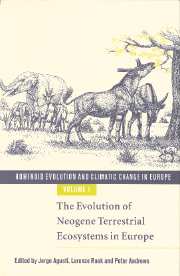Book contents
- Frontmatter
- Contents
- List of contributors
- Acknowledgements: The European Science Foundation
- 1 Introduction
- PART I Palaeogeography of the circum-Mediterranean region
- 2 Mediterranean and Paratethys Palaeogeography during the Oligocene and Miocene
- 3 Pliocene tephra correlations between East African hominid localities, the Gulf of Aden, and the Arabian Sea
- 4 Climatic perspectives for Neogene environmental reconstructions
- PART II Miocene mammalian successions
- PART III Palaeoenvironments: non-mammalian evidence
- PART IV Palaeoenvironments: mammalian evidence
- Index
3 - Pliocene tephra correlations between East African hominid localities, the Gulf of Aden, and the Arabian Sea
from PART I - Palaeogeography of the circum-Mediterranean region
Published online by Cambridge University Press: 15 December 2009
- Frontmatter
- Contents
- List of contributors
- Acknowledgements: The European Science Foundation
- 1 Introduction
- PART I Palaeogeography of the circum-Mediterranean region
- 2 Mediterranean and Paratethys Palaeogeography during the Oligocene and Miocene
- 3 Pliocene tephra correlations between East African hominid localities, the Gulf of Aden, and the Arabian Sea
- 4 Climatic perspectives for Neogene environmental reconstructions
- PART II Miocene mammalian successions
- PART III Palaeoenvironments: non-mammalian evidence
- PART IV Palaeoenvironments: mammalian evidence
- Index
Summary
Introduction
The Pliocene–Pleistocene chronology of hominid and other vertebrate evolution in East Africa is largely constrained by isotopic dating and regional intercorrelation of volcanic ash layers. Some eruptions were of sufficient magnitude or duration that their widespread tephra dispersal defines a series of dated marker horizons throughout the fossil-bearing sedimentary deposits of Tanzania, Uganda, Kenya, and Ethiopia (Brown, 1982; Feibel et al., 1989; Haileab & Brown, 1992, 1994; Pickford et al., 1991; WoldeGabriel et al., 1994). Although many of the larger eruptive events have been dated directly the ages of many tephra are only constrained by indirect stratigraphic interpolation between dated levels. The geochemical compositions of volcanic glasses from each eruption are unique, providing a definitive means to establish broad tephrostratigraphic correlations linking the regional climatic, tectonic, and biologic histories of this distinctive archive of Earth history.
This same tephrostratigraphic approach has been used to extend the East African tephra correlations into the continuous and well-dated marine sediment record of regional and global paleoclimate variability (Brown et al., 1992; Sarna-Wojcicki et al., 1985). These authors identified several megascopic volcanic ash layers within Deep-Sea Drilling Project (DSDP) sites from the Gulf of Aden, nearly 1000km northeast of hominid localities in Ethiopia and Kenya. Major element chemistries of volcanic glass shards extracted from these marine sediments were used to establish precise tephrostratigraphic correlations into the fossil-bearing East African sedimentary sequences. Moreover, controversy concerning the ages of specific eruptive eventswhich then defined key temporal junctures in early hominid evolution could be tested using the independent marine sediment chronostratigraphic framework (Brown et al., 1992; Sarna-Wojcicki et al., 1985).
- Type
- Chapter
- Information
- Hominoid Evolution and Climatic Change in Europe , pp. 23 - 54Publisher: Cambridge University PressPrint publication year: 1999
- 14
- Cited by



